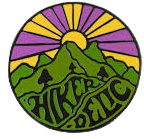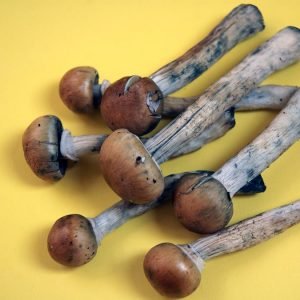Common or street names: Magic Mushrooms, Mushrooms, Sacred Mushroom, Shrooms, Little Smoke, Purple Passion
What is Psilocybin (Magic Mushrooms)?
Psilocybin (4-phosphoryloxy-N,N-dimethyltryptamine) and psilocin are chemical compounds obtained from certain types of dried or fresh hallucinogenic mushrooms found in Mexico, South America and the southern and northwest regions of the United States. Psilocybin is classified as an indole-alkylamine (tryptamine). These compounds have similar structure to lysergic acid diethylamide (LSD), and are abused for their hallucinogenic and euphoric effects to produce a “trip”. Hallucinogenic (psychedelic) effects are probably due to action on central nervous system serotonin (5-HT) receptors.
There are over 180 species of mushrooms that contain the chemicals psilocybin or psilocin. Like the peyote (mescaline), hallucinogenic mushrooms have been used in native or religious rites for centuries. Both psilocybin and psilocin can also be produced synthetically in the lab. There have been reports that psilocybin bought on the streets can actually be other species of mushrooms laced with LSD.
Methods of Psilocybin Use
“Magic Mushrooms” have long, slender stems which may appear white or greyish topped by caps with dark gills on the underside. Dried mushrooms are usually a reddish rust brown color with isolated areas of off-white. Mushrooms are ingested orally and may be made into a tea or mixed into other foods. The mushrooms may be used as fresh or dried product. Psilocybin has a bitter, unpalatable taste.
A “bad trip”, or a unpleasant or even terrifying experience, may occur with any dose of psilocybin. In general, dried mushrooms contain about 0.2% to 0.4% psilocybin and only trace amounts of psilocin. The typical dose of psilocybin used for recreational purposes varies, with peak effects occurring in 1 to 2 hours, and lasting for about six hours.
Dose and effects can vary considerably depending upon mushroom type, method of preparation, and tolerance of the individual. It can be difficult to determine the exact species of mushroom or how much hallucinogen each mushroom contains. Initial smaller doses and a longer period of time to determine the effects may be a safer option if you choose to use psilocybin for recreational purposes.
Effects of ‘Magic Mushroom’ Use
Psilocybin effects are similar to those of other hallucinogens, such as mescaline from peyote or LSD. The psychological reaction to psilocybin use include visual and auditory hallucinations and an inability to discern fantasy from reality. Panic reactions and psychosis also may occur, particularly if large doses of psilocybin are ingested.
Hallucinogens that interfere with the action of the brain chemical serotonin may alter:
- mood
- sensory perception
- sleep
- hunger
- body temperature
- sexual behavior
- muscle control
Physical effects of psychedelic mushrooms may include a feeling of nausea, vomiting, muscle weakness, confusion, and a lack of coordination. Combined use with other substances, such as alcohol and marijuana can heighten, or worsen all of these effects.
Other effects of hallucinogenic drugs can include:
- intensified feelings and sensory experiences
- changes in sense of time (for example, time passing by slowly)
- increased blood pressure, breathing rate, or body temperature
- loss of appetite
- dry mouth
- sleep problems
- mixed senses (such as “seeing” sounds or “hearing” colors)
- spiritual experiences
- feelings of relaxation or detachment from self/environment
- uncoordinated movements
- lowered inhibition
- excessive sweating
- panic
- paranoia – extreme and unreasonable distrust of others
- psychosis – disordered thinking detached from reality
Larger psilocybin doses, including an overdose, can lead to intense hallucinogenic effects over a longer period of time. An intense “trip” episode may occur, which may involve panic, paranoia, psychosis, frightful visualizations (“bad trip”), and very rarely death. Memory of a “bad trip” can last a lifetime.
Abuse of psilocybin mushrooms could also lead to toxicity or death if a poisonous mushroom is incorrectly thought to be a “magic” mushroom and ingested. If vomiting, diarrhea, or stomach cramps begin several hours after consuming the mushrooms, the possibility of poisoning with toxic mushrooms should be considered, and emergency medical care should be sought immediately.
Tolerance to the use of psilocybin has been reported, which means a person needs an increasing larger dose to get the same hallucinogenic effect. “Flashbacks”, similar to those occur in some people after using LSD, have also been reported with mushrooms. It is reported that people who use LSD or mescaline can build a cross-tolerance to psilocybin, as well.
How Long Do Mushrooms Stay in Your System?
Common hallucinogens, with the possible exception of phencyclidine (PCP), are not usually tested for on standard workplace drug screens. However, if desired by legal authorities, medical personnel, or an employer, it is possible to perform laboratory assays that can detect any drug or metabolite, including psilocybin, via advanced techniques.
When tested via urine, the psilocybin mushroom metabolite psilocin can stay in your system for up to 3 days. However, metabolic rate, age, weight, age, medical conditions, drug tolerance, other drugs or medications used, and urine pH of each individual may affect actual detection periods.
Extent of Hallucinogenic Mushroom Use
Based on a 2018 survey from SAMHSA’s National Survey on Drug Use and Health (NSDUH), about 5.6 million people aged 12 or older reported using hallucinogens (which may include psilocybin mushrooms) in the year prior to the survey. In 2017, that number was roughly 5.1 million. In the survey, hallucinogens include not only psilocybin from mushrooms, but also other psychedelic drugs like LSD, MDMA (Ecstasy, Molly), and peyote (mescaline). In comparison, 43.5 million people used marijuana in the year prior to the 2018 survey.
In 2018, there were 1.1 million people aged 12 and older who had used hallucinogens for the first timewithin the past year. In particular, college students, and people ages 18 to 25, may choose mushrooms as a drug of abuse.
Are Mushrooms Legal in the U.S.?
Psilocybin is a Schedule I substance under the DEA’s Controlled Substances Act, which means that it has a high potential for abuse, no currently accepted medical use in treatment in the U.S., and a lack of accepted safety for use under medical supervision. There are no commercial uses for psilocybin.
Currently, psilocybin is not available to doctors in the clinical setting because it is listed as a Schedule I drug by the US Drug Enforcement Agency (DEA). Researchers may only be able to get access to the illegal compound for the study through special waivers from the U.S. Food and Drug Administration (FDA). Other drugs found in Schedule I include marijuana, LSD, and heroin. In order for psilocybin to be prescribed for patients, it would have to be reclassified as a Schedule II medication, meaning it has a currently accepted medical use, but with severe restrictions due to addiction potential.
Medical Uses and Clinical Studies for Psilocybin
Although psilocybin has been used for centuries in rituals, modern medicine has recently reported clinical studies, as well. A report was published in the Journal of Psychopharmacology detailing two small studies that noted the ingredient in “magic mushrooms” – psilocybin – can reverse the feeling of “existential distress” that patients often feel after being treated for cancer. Reportedly, cancer can leave patients with this type of psychiatric disorder, feeling that life has no meaning. Typical treatments such as antidepressants may not be effective. However, use of a single dose of synthetic psilocybin reversed the distress felt by the patients and was a long-term effect. Some advanced cancer patients described the effect from the drug as if “the cloud of doom seemed to lift.”
Two additional studies using psilocybin were completed: one at New York University (NYU) Langone Medical Center in New York City and one at Johns Hopkins Medical School in Baltimore. For both studies, trained monitors were with patients as they experienced the effects of the drug, which can lead to hallucinations.
- In the NYU study, 29 patients with advanced cancer were given either a single dose of psilocybin or the B vitamin known as niacin, both in conjunction with psychotherapy. After seven weeks, the patients switched treatments (a cross-over study). In 60% to 80% of the patients receiving psilocybin, a relief from distress occurred rapidly and lasted over six months. The long-term effect was evaluated by researchers looking at test scores for depression and anxiety.
- In the Johns Hopkins study, researchers treated 51 adults with advanced cancer with a small dose of psilocybin followed five weeks later with a higher dose, with a 6-month follow-up. As with the NYU study, about 80% of participants experienced clinically significant relief from their anxiety and depression that lasted up to six months.
At the Center for Psychedelic and Consciousness Research at Johns Hopkins University in Baltimore, Maryland, researchers are focusing on how psychedelics affect behavior, mood, cognition, brain function, and biological markers of health. This research group was the first to obtain U.S. regulatory approval to continue research with psychedelics in healthy volunteers.
Additional studies with psilocybin are expected, and one is comparing the chemical against a leading traditional antidepressant.
As reported by Johns Hopkins, upcoming studies will evaluate the use of psilocybin as a new therapy for opioid addiction, Alzheimer’s disease, post-traumatic stress disorder (PTSD), post-treatment Lyme disease syndrome (formerly known as chronic Lyme disease), anorexia nervosa and alcohol use in people with major depression. A focus on precision medicine tailored to the individual patient is expected.
In November 2019, the FDA designated psilocybin therapy as a “breakthrough therapy” for depression to the Usona Institute, an action the agency uses to speed up development and review of investigational drugs. Breakthrough therapies are expected to provide a major improvement over currently available agents for an unmet medical need.
Usona’s PSIL201 psilocybin U.S. clinical trial is a Phase 2 study evaluating psilocybin as a treatment for Major Depressive Disorder (MDD). This research will use a randomized, double-blind, placebo-controlled study design to measure the antidepressant effects of a single dose of psilocybin in 80 patients between 21 to 65 years of age with MDD. According to the manufacturer, “psilocybin potentially offers a novel paradigm in which a short-acting compound imparts profound alterations in consciousness and could enable long-term remission of depressive symptoms.”
If FDA-approved, psilocybin would have to be reclassified by the DEA for it to be available for patients; it is currently classified as a Schedule I drug.

